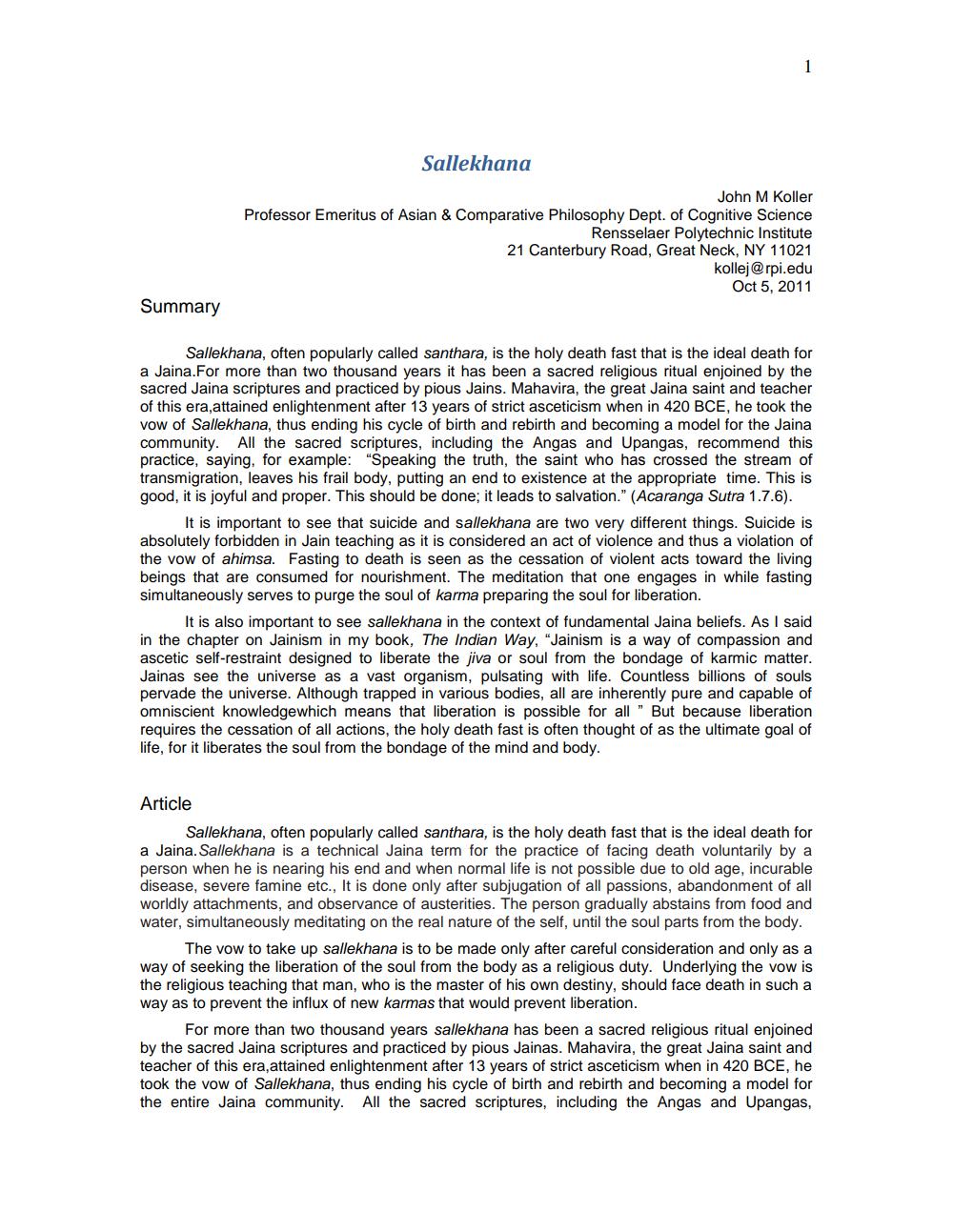________________
Summary
Sallekhana
1
John M Koller
Professor Emeritus of Asian & Comparative Philosophy Dept. of Cognitive Science Rensselaer Polytechnic Institute 21 Canterbury Road, Great Neck, NY 11021 kollej@rpi.edu Oct 5, 2011
Sallekhana, often popularly called santhara, is the holy death fast that is the ideal death for a Jaina.For more than two thousand years it has been a sacred religious ritual enjoined by the sacred Jaina scriptures and practiced by pious Jains. Mahavira, the great Jaina saint and teacher of this era,attained enlightenment after 13 years of strict asceticism when in 420 BCE, he took the vow of Sallekhana, thus ending his cycle of birth and rebirth and becoming a model for the Jaina community. All the sacred scriptures, including the Angas and Upangas, recommend this practice, saying, for example: "Speaking the truth, the saint who has crossed the stream of transmigration, leaves his frail body, putting an end to existence at the appropriate time. This is good, it is joyful and proper. This should be done; it leads to salvation." (Acaranga Sutra 1.7.6).
Article
It is important to see that suicide and sallekhana are two very different things. Suicide is absolutely forbidden in Jain teaching as it is considered an act of violence and thus a violation of the vow of ahimsa. Fasting to death is seen as the cessation of violent acts toward the living beings that are consumed for nourishment. The meditation that one engages in while fasting simultaneously serves to purge the soul of karma preparing the soul for liberation.
It is also important to see sallekhana in the context of fundamental Jaina beliefs. As I said in the chapter on Jainism in my book, The Indian Way, "Jainism is a way of compassion and ascetic self-restraint designed to liberate the jiva or soul from the bondage of karmic matter. Jainas see the universe as a vast organism, pulsating with life. Countless billions of souls pervade the universe. Although trapped in various bodies, all are inherently pure and capable of omniscient knowledge which means that liberation is possible for all " But because liberation requires the cessation of all actions, the holy death fast is often thought of as the ultimate goal of life, for it liberates the soul from the bondage of the mind and body.
Sallekhana, often popularly called santhara, is the holy death fast that is the ideal death for a Jaina. Sallekhana is a technical Jaina term for the practice of facing death voluntarily by a person when he is nearing his end and when normal life is not possible due to old age, incurable disease, severe famine etc., It is done only after subjugation of all passions, abandonment of all worldly attachments, and observance of austerities. The person gradually abstains from food and water, simultaneously meditating on the real nature of the self, until the soul parts from the body.
The vow to take up sallekhana is to be made only after careful consideration and only as a way of seeking the liberation of the soul from the body as a religious duty. Underlying the vow is the religious teaching that man, who is the master of his own destiny, should face death in such a way as to prevent the influx of new karmas that would prevent liberation.
For more than two thousand years sallekhana has been a sacred religious ritual enjoined by the sacred Jaina scriptures and practiced by pious Jainas. Mahavira, the great Jaina saint and teacher of this era, attained enlightenment after 13 years of strict asceticism when in 420 BCE, he took the vow of Sallekhana, thus ending his cycle of birth and rebirth and becoming a model for the entire Jaina community. All the sacred scriptures, including the Angas and Upangas,




